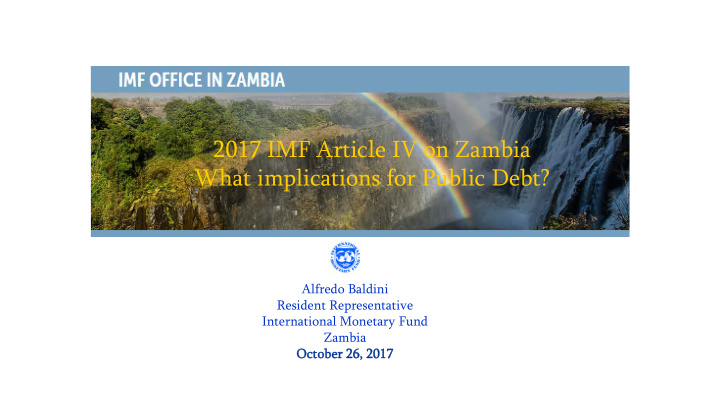



2017 IMF Article IV on Zambia What implications for Public Debt? Alfredo Baldini Resident Representative International Monetary Fund Zambia Oct ctober 26, 26, 2017 2017
Outline 1. Main take-aways from the 2017 Article IV for Zambia 2. Main take-aways from the 2017 DSA 3. Risks and Policy Advice On October 6, 2017, the Executive Board of the IMF concluded the Article IV consultation with Zambia and issued a press release. All the related Staff reports have been published on October 25 on www.imf.org public website. http://www.imf.org/en/Publications/CR/Issues/2017/10/25/Zambia-2017-Article-IV-Consultation-Press-Release-Staff-Report-and-Statement-by- the-45358
4. Main takeaways from the Article IV - Zambia • The near-term outlook for the Zambian economy has improved in recent months, driven by good rains and rising world copper price. • Tight monetary policy succeeded in stabilizing the exchange rate and slowing down y-o-y inflation to 6.6 percent in September 2017,
4. Main takeaways from the Article IV - Zambia • Despite recent unwinding, monetary policy tightening contributed to sharp rise in lending rates… • …with GRZ domestic arrears, rise in NPLs (12.1 percent of totals loans July 2017) and a plunge in the growth of credit to the private sector
4. Main takeaways from the Article IV for Zambia • Public debt has been rising Percent of GDP at an unsustainable pace and has crowded out lending to the private sector and increased the vulnerability of the economy. • The outstanding public and publicly guaranteed debt rose sharply from 36 percent of GDP at end-2014 to 60 percent at end-2016, driven largely by external borrowing and the impact of exchange rate depreciation.
Risks External Domestic • High: tighter and more volatile global • High: delayed fiscal financial conditions - Increased adjustment/Sharply rising Public external commercial borrowing costs debt will squeeze fiscal space for priority spending. • Medium to High: Policy Inconsistency - the government should speak with one voice on key objectives and policies. • Medium: Volatility in global copper • Medium Rising political tensions - prices - Maintain exchange rate Maintain the relative political flexibility and build resilience against stability enjoyed by Zambia over the external shocks by strengthening the years to sustain investor confidence efforts to diversify the economy. in the economy.
The IMF Directors Views • Directors expressed concern at the pace at which public debt, especially external debt, has increased and now put Zambia at high risk of debt distress. • OK the need to address infrastructure gaps, but to maintain debt sustainability, it is critical to slow down on the contraction of new debt, especially non-concessional loans, strengthen debt management capacity, and improve project appraisal and selection processes. http://www.imf.org/en/News/Articles/2017/10/10/pr17394-imf-executive-board-concludes-2017-article-iv- consultation-with-zambia
Zambia DSA Conclusions: 2013-17 2017 2015 2013 Risk of debt Distress (current policies) High Moderate Low Augmented by significant Risks stemming from domestic public and/or Yes Yes No private external debt? 2017 joint IMF-WB DSA for Zambia: further downgrading October 2017
Main Joint IMF-WB DSA Take-aways #1 The present value (PV) of PPG #3 All indicators breach their external debt breaches the 40 respective thresholds in the case of percent of GDP threshold ; it rises extreme shocks. from 37 percent in 2016 to 42.6 percent by 2019 and to a peak of #4 The fixed primary balance 44.3 percent in 2022. scenario , which keeps the primary deficit-to-GDP ratio unchanged from #2 The debt-service-to-revenue 2016 (at 2.2 percent), shows the ratio temporarily breaches its 20 debt ratio rising throughout the percent threshold in 2022 and 2024 forecast period , highlighting the when Eurobond payments fall due. urgent need for fiscal consolidation.
Evolution of Debt Indicators (2017 DSA – Art. IV)
IMF Policy Advice and Authorities views Authorities views Fiscal consolidation • The authorities broadly agreed with • Debt dynamics improve the DSA assessment. substantially under an • They will publish the Medium-Term Debt Strategy which will guide adjustment policies scenario. government borrowing, with a view to ensuring that public debt remains at • Fiscal consolidation, restraint on sustainable levels. non-concessional borrowing, • In this context, they will seek to and strengthened debt and • (i) maximize concessional loans and public investment management • (ii) strengthen parliamentary over- capacities are needed to put sight of public borrowing through an amendment to the Loans and debt on a sustainable path. Guarantees Act.
Macro-Fiscal Scenarios (2017 DSA – Art. IV)
Thank you Natotela Zikomo Very Sana Kwambili much http://www.imf.org/en/Publications/CR/Issues/2017/10/25/Zambia-2017-Article-IV- Consultation-Press-Release-Staff-Report-and-Statement-by-the-45358
Recommend
More recommend